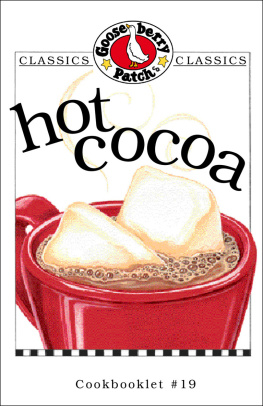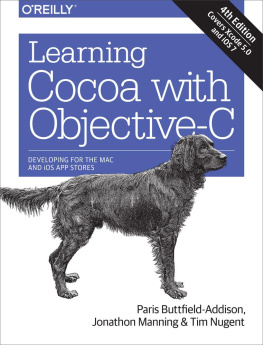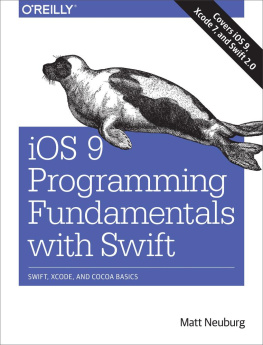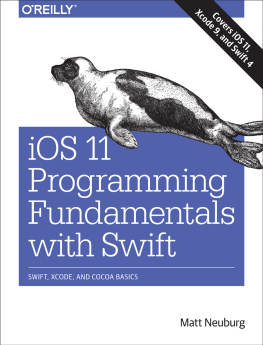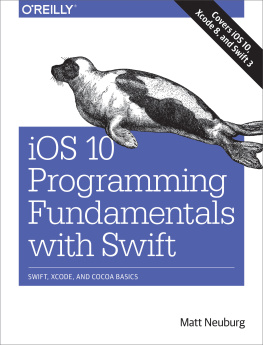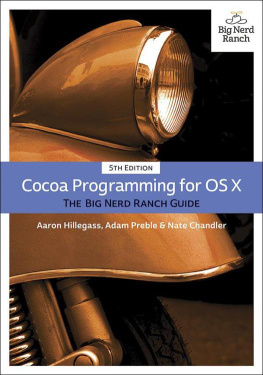Its practically impossible to know Cocoa inside andout. There was once a discussion between two programmers aboutCocoas large APIs: one was a veteran Perlprogrammer, the other a Cocoa programmer. The Perl programmergrumbled about the intimidating and verbose Cocoa APIs, saying therewas simply too much to remember. Bemused, the Cocoa programmerretorted: You dont remember Cocoa; you look itup!
The point the Cocoa programmer was trying to impress upon the Perlprogrammer was that understanding object-oriented programming(OOP) concepts and the architecture of the frameworks is moreimportant than remembering the wordy and numerous method and classnames in the Cocoa frameworks.
This book is a compact reference that will hopefully grow worn besideyour keyboard. Split into two parts, Cocoa in aNutshell first provides an overview of the frameworks thatfocuses on both common programming tasks and how the parts of theframework interact with one another. The second part of the book isan API quick reference that frees you from having to remember methodand class names so you can spend more time hacking code. This bookcovers the Cocoa frameworksFoundation and Application Kit(AppKit)as of Mac OS X 10.2 (Jaguar).
What Is Cocoa?
Cocoa is acomplete set of classes and application programming interfaces (APIs)for building Mac OS X applications and tools. With over 240 classes,Cocoa is divided into two essential frameworks: the Foundationframework and the Application Kit.
The Foundationframework provides a fundamental set of tools for representingfundamental data types, accessing operating system services,threading, messaging, and more. The ApplicationKit provides the functionality to build graphical user interfaces(GUI) for Cocoa applications. It provides access to the standard Aquainterface components ranging from menus, buttons, and textfieldsthe building blocks of larger interfacestocomplete, prepackaged interfaces for print dialogs, file operationdialogs, and alert dialogs. The Application Kit also provideshigher-level functionality to implement multiple documentapplications, text handling, and graphics.
Classes are not the only constituents of the Cocoa frameworks. Someprogramming tasks, such as sounding a system beep, are bestaccomplished with a simple C function. Cocoa includes a number offunctions for accomplishing tasks such as manipulating byte ordersand drawing simple graphics. Additionally, Cocoa defines a number ofcustom data types and constants to provide a higher degree ofabstraction to many method parameters.
The Cocoa Development Environment
Project Builder and Interface Builder are the two most importantapplications used in Cocoa development. ProjectBuilder is the interactive developmentenvironment (IDE) for Mac OS X used to manage and edit source files,libraries, frameworks, and resources. Additionally, it provides aninterface to the Objective-C compiler, gcc, andthe GNU debugger, gdb.
Interface Builder is usedto create GUIs for Cocoa applications by allowing developers tomanipulate UI components (such as windows and buttons) graphicallyusing drag and drop. It provides assistance for laying out componentsby providing visual cues that conform to ApplesAqua Human Interface Guidelines. Froman inspector panel, the behavior and appearance of these componentscan be tweaked in almost every way the component supports. InterfaceBuilder provides an intuitive way to connect objects by letting theuser drag wires between objects. This way, you set up the initialnetwork of objects in the interface. In addition, you can interfacewithout having to compile a single bit of code.
Interface components are not the only objects that can be manipulatedwith Interface Builder. You can subclass any Cocoa class and createinstances of the subclasses. More importantly, you can give theseclasses instance variables, known as outlets ,and methods, called actions , and hook them up to user interfacecomponents. Interface Builder can then create source files for thesesubclasses, complete header files, and an implementation fileincluding stubs for the action methods. There is much more toInterface Builder and Project Builder than we can cover in this book,but as you can begin to imagine, the tight integration of these twoapplications create a compelling application development environment.
Cocoa Design Patterns
Cocoa uses many design patterns. Designpatterns aredescriptions of common object-oriented programming practices.Effective application development requires that you know how andwhere to use patterns in Cocoa. Cocoa in aNutshell discusses these patterns in the context in whichthey are used. Here is a brief list of the design patterns you willencounter in the book:
Delegation
In this pattern, one object, the delegate, acts on behalf of anotherobject. Delegation is used to alter the behavior of an object thattakes a delegate. The developers job is toimplement any number of methods that may be invoked in the delegate.Delegation minimizes the need to subclass objects to extend theirfunctionality.
Singleton
This pattern ensures that only one object instance of a class existsin the system. A singleton method is an objectconstructor that creates an instance of the class and maintains areference to that object. Subsequent invocations of the singletonconstructor return the existing object, rather than create a new one.
Notification
.
Model-View-Control
The discusses MVC in more detail.
Target/action
The discusses this topic further.
Responder chain
The .
Key-value coding
covers key-value coding more thoroughly.
Benefits
These days, application developers expect a lot from their tools, andusers expect a lot from any application they use. Any application orapplication toolkit that neglects these needs is destined forfailure. Cocoa comes through grandly by providing the features neededin applications now and in the future, including:
Framework-based development
Cocoa development is based on its frameworks: the Foundationframework and the Application Kit. With framework-based programming,the system takes a central role in the life of an application bycalling out to code that you provide. This role allows the frameworksto take care of an applications behind-the-scenedetails and lets you focus on providing the functionality that makesyour application unique.
For free features
Cocoa provides a lot of standard application functionalityfor free as part of theframeworks. These features not only include the large number ofuser-interface components, but larger application subsystems such asthe text-handling system and the document-based applicationarchitecture. Because Apple has gone to great lengths to providethese features as a part of Cocoa, developers can spend less timedoing the repetitive work that is common between all applications,and more time adding unique value to their application.
The development environment
As discussed earlier, Project Builder and Interface Builder provide adevelopment environment that is highly integrated with the Cocoaframeworks. Interface Builder is used to quickly build userinterfaces, which means less tedious work for the developer.
Cocoas most important benefit is that it lets youdevelop applications dramatically faster than with other applicationframeworks.



